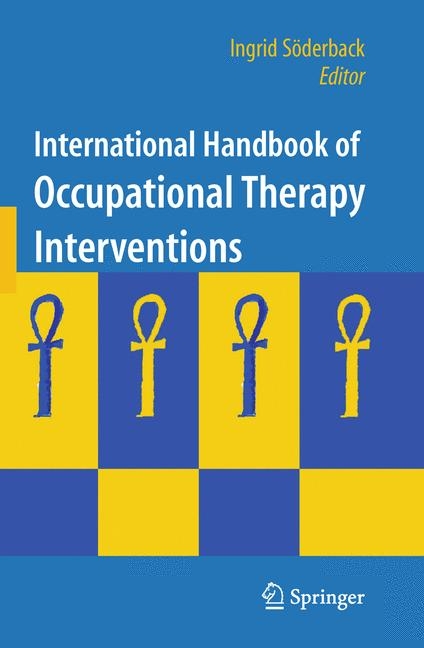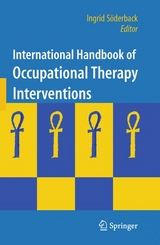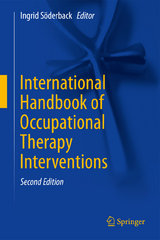International Handbook of Occupational Therapy Interventions
Springer-Verlag New York Inc.
978-1-4419-6739-8 (ISBN)
- Titel erscheint in neuer Auflage
- Artikel merken
Resources for rehabilitation specialists tend to follow a straight line: injury—disability—limitation—intervention. The International Handbook of Occupational Therapy Interventions breaks with this tradition, organized by type of intervention (based on recommendations in the International Classification of Functioning) rather than disability, medical condition, or level of impairment. This innovative, user-friendly system identifies candidates for particular interventions in terms of the range of syndromes and illnesses they are applicable to, encouraging critical thinking, problem solving, and best practice. The book’s wide spectrum of interventions coupled with its international perspective creates a unique source of evidence-based strategies for improving patients’ adaptation, functioning, relearning, recovery, and the prevention of ill health.
The Handbook:
Describes interventions in such areas as environmental accessibility, ergonomics, pain management, sensory functional training, electric prostheses, music therapy, psychoeducation, and cognitive teaching.
Features interventions suited to all areas of daily life: self maintenance, home, work, and leisure.
Clarifies the occupational therapist’s role in multidisciplinary care.
Includes material on accident/illness prevention and health promotion strategies.
Supplies reference lists of studies regarding the clinical efficacy of interventions.
Demonstrates the use of a common technical language for the field.
Occupational and physical therapists, rehabilitation nurses and technicians, physiatrists, and health psychologists will find the International Handbook of Occupational Therapy Interventions a source of practice-enhancing tools and ideas. Its clarity of presentation makes it highly useful to readers in related fields (such as insurance case workers and ergonomic architects and engineers) as well.
Dr. Söderback is an Associate Professor of Occupational Therapy and Rehabilitation at the Karolinska Institute, Stockholm, Sweden and University Lecturer Emerita associated to the Department of Public Health and Caring Science at Uppsala University in Sweden. She has worked for 40 years in occupational therapy, health care, and rehabilitation. She is an Associate Editor of the Journal Occupational Therapy International, and she is the coauthor of Occupational Therapy & Ergonomics.
Introduction.
The Genesis of the Handbook: Material and Methods. Occupational Therapy: Emphasis on Clinical Practice. Adaptive Interventions: Overview.-
Interventions: The OT Manages for Adaptation.
Introduction. Adaptive Interventions: Overview.-
Environmental Adaptations. Environmental Adaptation for Older Adults And Their Families in The Home and Community. Housing Adaptations: Current Practice and Future Challenges.-
Accessibility. Ergonomic Workplace Interventions for Computer Users with Cumulative Trauma Disorders.-
Accommodation. Optimal Positioning: Wheelchair Seating Comfort: Pressure Mapping. Wheelchair Intervention: Principles and Practice.-
Electric Prostheses, Orthotics & Splints. FES-Therapy (FES-T): Individualized Neuroprosthesis for Grasping and Reaching. Splints: Mobilization, Corrective Splintage and Pressure Therapy for The Acutely Injured Hand. Splinting: Positioning, Edema and Scar Management Due to Burn Injury.-
Assistive Devices. Assistive Devices for Children with Disabilities. Low-vision Intervention: Decision-making for Acquiring and Integrating Assistive Technology.-
Universal Design. Universal Design: Principles and Practice for People with Disabilities. The Design of Artisans Hand Tools: Users’ Perceived Comfort and Discomfort.-
Temporal Adaptation. Temporal Adaptation and Individuals Living with Serious Mental Illness in the Community.-
Interventions: The OT Teaches for Learning.
Introduction. Learning Interventions: Overview.-
Cognitive Teaching Approaches and the Behavioral Teaching Approach. Problem Solving: A Teaching and Therapeutic Tool for Older Adults and Their Families. Teaching and Supporting Clients with Dementia and their Caregivers in Daily Functioning.-
Cognitive Teaching Approaches: The Dialogue Technique Approach. Meta-cognitive Occupation-based Training in Traumatic Brain Injury. Meta-cognitive Mental Imagery Strategies for Training Daily Living Skills in People with Brain Damage. The Self-Regulation and Mental Imagery Program. Strategies to Compensate for Apraxia among Stroke Clients.-
Programs for Active Learning. Delivering Energy Conservation Education to People with Multiple Sclerosis by Teleconference. Psycho-educational Groups. Illness Management Training: Transforming Elapse and Instilling Prosperity (TRIP) in an Acute Psychiatric Ward.- Psychosocial Intervention in Schizophrenia. Intervention in Panic and Anxiety Disorders through Lifestyle Modification. Behavioral Approach to Rehabilitation of Patients with Substance–use Disorders.-
Neuromusculoskeletal and Movement-related Learning. Trunk Restraint: Physical Intervention for Improvement of Upper-Limb Motor Impairment and Function. Constraint-Induced Movement Therapy (CIT) for Restoration of Upper-limb Function.- I: Introduction. Constraint-Induced Movement Therapy (CIT) for Restoration of Upper-limb Function.- II: Hemipareses Application. Strategies for Cueing with Self Speech among People Living with Parkinson’s Disease. Joint Protection: Enabling Change in Musculoskeletal Conditions.-
Sensory Functional Training. Neuro-developmental Therapy. Sensory Integration and Vestibular Stimulation. Interventions among Mentally Retarded Children. Upper-limb Movement Training in Children following Injection of Botulinum Toxin-A. Pain Management: Multidisciplinary: Back Schools and Future E-health Interventions for Chronic Pain Sufferers. Pain Management: Functional Restoration for Chronic Low-back Pain Clients.-
Learning Approaches for Participation in Working Life. Occupational Rehabilitation: The Principles and Practice of Work and Ergonomics.- Reintegration to Work among People Suffering from Depression. Supported Employment for Individuals with Severe Mental Illness. Individual Placement and Support (IPS). Helping People with Severe Mental Illness Get Real Jobs. Conducting Transitional Strategies that Support Children with Special Needs to Assume Adult Roles.-
Interventions: The OT Enables for Recovery. Introduction. Recovery Interventions: Overview.-
Engagement in Occupations. Creating Opportunities for Participation within and beyond Mental Health Day Health Services. Conducting an Intervention Program Mediated by Recreational Activities and Socialization in Groups among Clients with Alzheimer’s Disease. Horticultural Therapy for the Cognitive Function of Elderly People with Dementia.-
Engagement in Music. Medical Music Therapy: Evidence-based Principles and Practices. Music as a Resource for Health and Wellbeing.-
Interventions: The OT Promotes Health and Wellness. Introduction. Introduction. Preventative Interventions: Overview.-
Preventing Accidents in the Home. Preventing Falls Among Older People Using the "Stepping On" - A group-based Education Program. Preventive Home Visits to Older People. Does Education for Health-Care Professionals Increase the Effects.-
Preventing Traffic Accidents. Issues Related to Use of In-vehicle Intelligent Transport Systems by Drivers with Functional Impairments.-
Preventing Occupational Accidents at Work and Workplaces. Work-related Health. Organizational Factors and Well-being. Functional Capacity Evaluation. An Integrated Approach to Assessing Work Activity Limitation Using the GAPP FCE. Prevention of Workers’ Musculoskeletal Disorders: A Four Stage Prevention Model.-
Consultation in the Prevention of Illness. Motivational Interviewing: Enhancing Patient Motivation for Behavior Change. The Basic Elements Conducting about Evidence-Based Occupational Therapy.
| Zusatzinfo | XXVIII, 554 p. |
|---|---|
| Verlagsort | New York, NY |
| Sprache | englisch |
| Maße | 155 x 235 mm |
| Gewicht | 871 g |
| Themenwelt | Geisteswissenschaften ► Psychologie ► Sozialpsychologie |
| Medizin / Pharmazie ► Gesundheitsfachberufe | |
| Medizin / Pharmazie ► Physiotherapie / Ergotherapie ► Ergotherapie | |
| Medizin / Pharmazie ► Physiotherapie / Ergotherapie ► Rehabilitation | |
| ISBN-10 | 1-4419-6739-7 / 1441967397 |
| ISBN-13 | 978-1-4419-6739-8 / 9781441967398 |
| Zustand | Neuware |
| Haben Sie eine Frage zum Produkt? |
aus dem Bereich





